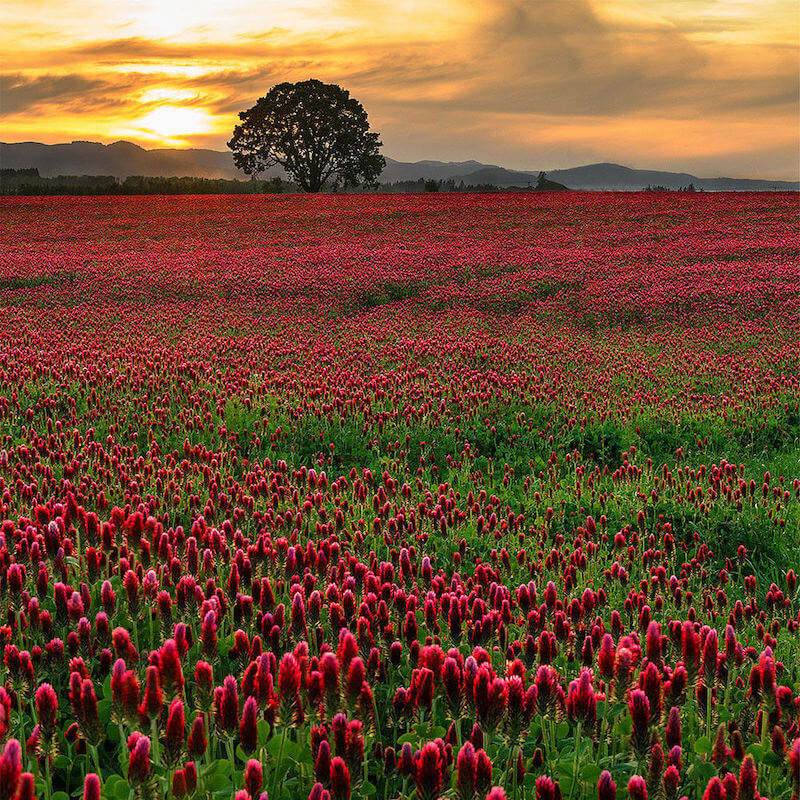
Crimson clover (*Trifolium incarnatum*) is a widely used annual legume native to the Mediterranean region. Known for its versatility, this pea-family plant serves as an excellent cover crop or forage crop in agricultural systems.
Crimson clover is a herbaceous plant that typically grows 1 to 2 feet tall, featuring a fibrous root system. Its trifoliate leaves—comprising three ovate or elliptical leaflets with a distinct V-shaped white marking—are a signature characteristic. The plant's vibrant crimson flowers form dense cylindrical spikes, while its fruit develops as small pods containing seeds.
This adaptable plant thrives in various soil types, but it grows best in well-drained loamy soil with a pH range of 6.0 to 7.5. Crimson clover flourishes in cool, moist climates and can withstand temperatures as low as 10°F. As an annual plant, it completes its life cycle in one growing season, typically being sown in the fall or early spring for either a winter or summer harvest.
Crimson clover is a popular cover crop because it enhances soil health and boosts productivity. Being a legume, it has the unique ability to fix atmospheric nitrogen, storing it in root nodules that enrich the soil for other plants. Incorporating a freshly turned clover crop into the soil has been shown to increase yields and lower fertilizer costs. Additionally, crimson clover improves soil structure, enhances water infiltration, and helps prevent erosion.
Beyond these agricultural benefits, crimson clover supports subterranean biodiversity. Its deep roots create habitats for earthworms and beneficial soil organisms, contributing to improved nutrient cycling and fertility. Furthermore, the plant’s nectar-rich flowers attract pollinators like bees, butterflies, hummingbirds, and even dragonflies, promoting a healthier ecosystem.

Crimson clover serves multiple purposes in agriculture, both as ground cover and a fodder plant. Its ability to fix atmospheric nitrogen significantly enhances soil fertility, benefiting future crops and reducing the reliance on synthetic fertilizers, making it a cost-effective option. Additionally, it is a high-quality feed source for livestock and plays a crucial role in honey production due to its nectar-rich flowers.
Crimson clover is an excellent source of animal feed, providing livestock with a nutrient-rich diet. High in protein, vitamins, and minerals, it improves the health and productivity of animals. It can be used in various forms, such as live grazing, dried and stored feed, or composted material to enhance soil fertility off-site.
Allowing livestock to graze directly on live crimson clover plants in the field provides a fresh, natural food source. This approach supports animal health while maintaining the vigor of the clover plants. Live grazing also reduces the labor and costs associated with harvesting and storing feed, making it an efficient feeding option.
Another practical use of crimson clover is cutting and drying the plants in the sun. Once dried, the clover can be stored and used as hay, silage, or a supplement to other feed sources. This method ensures a consistent feed supply, especially during the winter months, when fresh grazing may not be possible.
Crimson clover plant material can also be composted to create a nutrient-rich organic soil amendment. Composting breaks down the plants, producing a material that enhances soil fertility and structure. This compost can be applied to fields and gardens, promoting sustainable agriculture while reducing waste.
Crimson clover’s vibrant flowers are an important food source for pollinating insects, including bees, dragonflies, butterflies, hummingbirds, and even ants. By attracting these pollinators, crimson clover supports ecosystems and enhances biodiversity.
Bees are the primary pollinators of crimson clover, drawn to the plant’s bright red and purple flowers. Other pollinators, such as dragonflies, butterflies, and hummingbirds, also play a role in transferring pollen. Even ants contribute to pollination by interacting with the flowers.
Livestock, such as cattle, sheep, and goats, can inadvertently pollinate crimson clover as they walk through fields, transferring pollen between plants. While this effect is typically minor, it contributes to the plant’s reproductive process.
In addition to insects and animals, wind and rain assist in the pollination of crimson clover. The plant produces lightweight pollen grains that can be carried by the wind, while rain washes pollen from flowers to nearby plants, facilitating fertilization.
Ready to transform your land into a high-yield, sustainable farm? Let Crop Circle Farms design and build a custom, low-impact, and water-efficient farm tailored to your needs. Double your income and cut your costs in half! Contact Us
Help us expand our mission to revolutionize agriculture globally. We are seeking partners to implement Crop Circle Farms to feed people in need. Together, we can build scalable food production systems that save water, reduce costs, and feed thousands of people. Contact Growing To Give